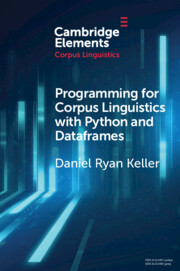Element contents
Programming for Corpus Linguistics with Python and Dataframes
Published online by Cambridge University Press: 24 May 2024
Summary
Keywords
- Type
- Element
- Information
- Series: Elements in Corpus LinguisticsOnline ISBN: 9781108904094Publisher: Cambridge University PressPrint publication: 20 June 2024

